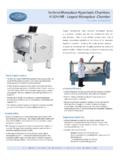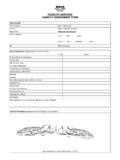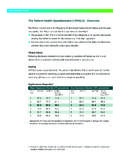Transcription of Diabetic Foot Ulcer Treatment - sechristusa.com
1 Diabetic foot Ulcer Treatment Using Hyperbaric Oxygen Therapy Guide Table of Contents Diabetic foot Ulcers & Hyperbaric Chamber 2 Hyperbaric Chamber/ Diabetic foot Ulcer 3 Hyperbaric Chamber Oxygen 5 The Benefits of Hyperbaric Chamber Therapy in the Treatment of Diabetic foot Ulcers .. 6 Improved Wound Care Programs ..7 Preparing Your Diabetic Patient for Hyperbaric Oxygen Therapy .. 8 Enhance Your Facility s Wound Care Program with a Sechrist Hyperbaric 9 Why Does Your Facility Need a Sechrist Hyperbaric Chamber? .. 10 Diabetic foot Ulcers & Side Effects of Hyperbaric Oxygen 12 Copywrite Sechrist Industries, Inc. 2008 Diabetic foot Ulcers & Hyperbaric Chamber Treatment Fifteen percent of all diabetics will develop Diabetic foot ulcers at some point.
2 Currently, more than 17 million people in the US have diabetes, with another one million cases diagnosed per year. Of these patients, up to 70% have some degree of Diabetic neuropathy or peripheral vascular disease, which can both lead to Diabetic foot ulcers. If left untreated, or even with full conventional Treatment , the ulcers may lead to serious consequences. These consequences include gangrene, infections and osteomyelitis. In addition, most Diabetic amputation cases begin with foot ulcers. If a patient s body exhibits an inability to heal on its own within one month of symptoms, it is likely that continued problems will exist, eventually leading to amputation.
3 Diabetic foot ulcers can, for many patients, seem to appear out of nowhere. Diabetics tend to lose sensation in the feet; therefore, they are more easily injured and they may not even notice that the injury has occurred. This can leave these ulcers untreated for a period of time and leave them susceptible to serious infection. Once a patient presents with a Diabetic foot Ulcer , a physician will need to determine if the Ulcer is ischemic (caused by narrowing of the arteries), neuropathic (actual injury to the nerve) or a combination of both. Traditional Treatment involves bandaging, using an anti-bacterial topical product and an orthotic to keep the pressure off the Ulcer .
4 This traditional method does not have an impressive success rate when used alone, but when combined with hyperbaric chamber Treatment , the statistics show a significant rise. For instance, diabetics suffering with foot ulcers who undergo traditional Treatment avoid amputation 61% of the time. However, with added hyperbaric oxygen therapy, the number rises to 89%. Hyperbaric oxygen therapy involves little participation from the patient. The patient simply lies inside the hyperbaric chamber and breathes normally. While in the chamber, the patient is exposed to 100% oxygen and 2 to 3 times the normal atmospheric pressure. This pressure is equivalent to a diver reaching 50 feet underwater.
5 This method of therapy exposes the infected tissues to high concentrations of oxygen. The atmospheric pressure increases the level of dissolved gases in the patient s blood by 2 to 3 times its normal amount. In other words, the oxygen dissolved in the blood increases from to References: Cianci P. Adjunctive hyperbaric oxygen therapy in the Treatment of the Diabetic foot . J Am Podiatr Med Assoc. 1994;84:448 455 Doctor N, Pandya S, Supe A. Hyperbaric oxygen therapy in Diabetic foot . J Postgrad Med. 1992;38:112 114 Hyperbaric Chamber/ Diabetic foot Ulcer FAQs What is hyperbaric oxygen therapy? Hyperbaric Oxygen Therapy is a Treatment option for Diabetic patients with a foot Ulcer , where the patient inhales 100% oxygen in a pressurized chamber.
6 This method helps the body increase the oxygen levels in the blood. It also exposes the affected tissues to more oxygen than would otherwise be present, thus allowing for enhanced healing. How does hyperbaric oxygen therapy work? Hyperbaric oxygen therapy increases the saturation of oxygen in the blood, due to the enhancement of atmospheric pressure. Increased oxygen can promote white blood cell activity, encourage tissue development and induce capillary growth. This method can be beneficial for a variety of conditions, but is proving exceptionally promising in the Treatment of Diabetic foot ulcers. What health issues can benefit from hyperbaric chamber treatments?
7 While Diabetic foot ulcers are the primary focus of this therapy, it is not the only condition that can benefit from hyperbaric chamber treatments. Hyperbaric chambers can be used to treat cyanide or carbon monoxide poisoning, decompression sickness, embolisms, compartment syndrome and thermal burns. These are only a short list of the possible uses for this technology. Is this Treatment painful and how much participation is required of the patient? No! This Treatment is not painful to the patient. A small degree of discomfort may be experienced from the increased pressure in the patients ears and sinuses. This feeling is similar to that experienced during a takeoff or landing in an aircraft.
8 The patient can relieve the pressure through yawning or other techniques. This method is actually relaxing. The patient can nap or watch an externally mounted TV and DVD player while safely receiving Treatment . There may be brief moments of interruption during periodic air breaks, but otherwise it is a very peaceful, healing experience. The patient is required to arrive for the appointment without perfumes, colognes or hair products. The temperature inside of the chamber will not vary from the temperature in the room so you may want to provide booties for the comfort of your patient. How many treatments are necessary? The amount of treatments will vary, according to the patient and the condition requiring Treatment .
9 For Diabetic foot ulcers, the course of Treatment can vary from approximately 20 to 40, 1 to 2 hour sessions, depending on the progress of the wound s healing. Are there any side effects? Hyperbaric chamber Treatment is extremely safe and side effects are rare. One in 10,000 people may incur oxygen toxicity. Others may experience vision changes or a dry cough, which usually clear up after Treatment is completed. If a patient suffers from claustrophobia, he/she may need to be educated on relaxation techniques, due to the enclosed space. Otherwise, hyperbaric chamber Treatment is one of the safest medical treatments available today. How successful is hyperbaric oxygen Treatment in treating Diabetic foot ulcers?
10 Without successful Treatment , Diabetic foot ulcers can eventually lead to amputation. 15% of diabetics will suffer foot ulcers at some point in their disease, and 80% of diabetes related amputations begin with these hard to heal ulcers. Traditional treatments are more successful when used in conjunction with hyperbaric chamber Treatment . The increase in success is due to the fact that the tissues around the Ulcer are exposed to increased oxygen and enhanced vascular healing. This technology does not replace the need for proper wound care and it should be utilized for patients who are not healing after one month of incurring the Ulcer . Will these treatments be covered by insurance?








